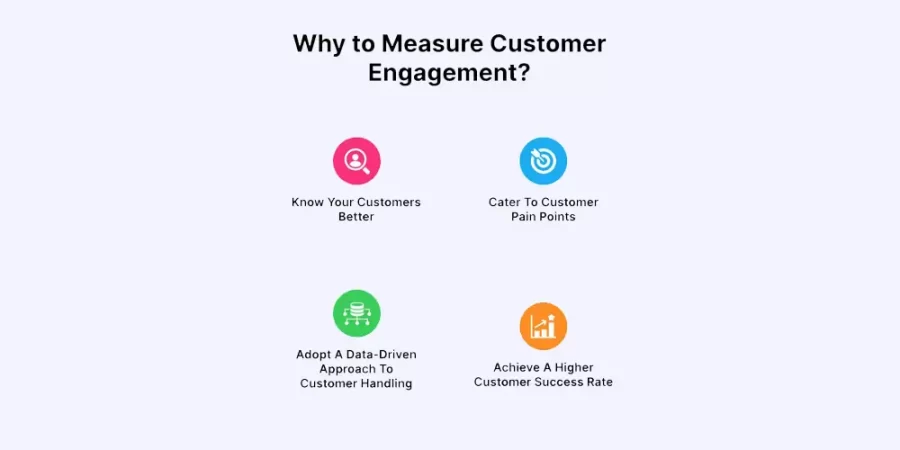Beginners Guide: How To Measure And Improve Customer Engagement?
Measuring and improving customer engagement is crucial for any business looking to increase customer loyalty and improve overall performance. Engaged customers are more likely to make repeat purchases, refer friends and family, and provide positive feedback. In this article, we will discuss various methods for measuring customer engagement and strategies for improving it.
First, let’s define what we mean by customer engagement. Customer engagement is the level of interaction and involvement that customers have with a company, its products or services, and its overall brand. It can include things like customer satisfaction, loyalty, and advocacy.
Measuring customer engagement can be done in a variety of ways, including:
- Surveys: Surveys are a common and effective way to measure customer engagement. They can be administered via email, phone, or in-person and can ask questions about customer satisfaction, loyalty, and brand perception.
- Net Promoter Score (NPS): NPS is a measure of customer loyalty and is calculated by asking customers how likely they are to recommend a company’s products or services to others. It is a simple and effective way to measure customer engagement.
- Customer Retention Rate: The customer retention rate is the percentage of customers who continue to do business with a company over a given period of time. A high retention rate is a strong indicator of customer engagement.
- Social Media Metrics: Social media metrics such as likes, shares, and comments can also be used to measure customer engagement. They can provide insight into how customers are interacting with a company’s brand and content.
- Customer Effort Score (CES): CES is a measure of how much effort customers have to put in to get their issues resolved. Lower CES means better customer engagement
Once you have a good understanding of your current level of customer engagement, you can start developing strategies to improve it. Some strategies include:
- Improving Customer Service: Providing excellent customer service is key to improving customer engagement. This can be done by hiring and training employees to be responsive, helpful, and friendly, as well as by implementing systems and processes that make it easy for customers to get the help they need.
- Personalization: Personalization is another important strategy for improving customer engagement. This can be done by using customer data to tailor products, services, and communications to individual customers. Personalized experiences can make customers feel valued and increase their engagement.
- Building Communities: Building a community of engaged customers can be a powerful way to improve customer engagement. This can be done by creating social media groups, hosting events, and encouraging customers to share their experiences and provide feedback.
- Providing value: Customers are more likely to be engaged with a company when they feel that they are getting value from their interactions. Providing valuable content or offers that align with customer’s needs, interests and goals can help increase engagement.
- Listening and acting on feedback: Actively listening to customers and taking action on their feedback can help improve customer engagement. This can be done by implementing customer feedback systems, conducting surveys, and hosting focus groups.
Measuring and improving customer engagement is crucial for businesses looking to increase customer loyalty and improve overall performance. By using the methods and strategies outlined in this article, you can get a better understanding of your current level of customer engagement and develop effective strategies for improving it.
It’s important to note that measuring and improving customer engagement is an ongoing process, not a one-time event. Regularly monitoring customer engagement levels and making adjustments as needed can help ensure that your customers remain engaged over time.
Another key aspect to consider when measuring and improving customer engagement is the role of technology. With the rise of digital communication channels, such as social media, email, and messaging apps, businesses have new opportunities to engage with customers in real-time. By leveraging these technologies, companies can create personalized, timely interactions that can increase customer engagement and build stronger relationships.
One example of how technology can be used to improve customer engagement is through the use of chatbots. Chatbots are computer programs that can simulate human conversation and can be used to answer customer questions, provide information, and even help customers place orders. By providing customers with quick and convenient access to information, chatbots can help increase customer engagement and satisfaction.
Another example of how technology can be used to improve customer engagement is through the use of customer relationship management (CRM) systems. CRM systems can help businesses collect and analyze customer data, and use it to create targeted marketing campaigns, personalize customer interactions, and provide better customer service. By using CRM systems to create a more personalized customer experience, companies can increase customer engagement and build stronger relationships.
In addition to technology, businesses can also use data analytics to improve customer engagement. By analyzing customer data, businesses can identify patterns and trends, and use this information to make informed decisions about how to improve customer engagement. This can include identifying which products or services are most popular, which marketing campaigns are most effective, and which customer service strategies are working best.
It’s also important to note that customer engagement is not just about the customer’s engagement with the company, but also the company’s engagement with the customer. This means that companies should be open to feedback, actively listen to customers, and act on the feedback. This will help customers feel heard, valued, and appreciated, which in turn will increase their engagement with the company.
Here are some detailed bullet points that summarize the key points discussed in the article about how to measure and improve customer engagement:
- Measuring customer engagement:
- Surveys: Surveys are a common and effective way to measure customer engagement. They can be administered via email, phone, or in-person and can ask questions about customer satisfaction, loyalty, and brand perception.
- Net Promoter Score (NPS): NPS is a measure of customer loyalty and is calculated by asking customers how likely they are to recommend a company’s products or services to others. It is a simple and effective way to measure customer engagement.
- Customer Retention Rate: The customer retention rate is the percentage of customers who continue to do business with a company over a given period of time. A high retention rate is a strong indicator of customer engagement.
- Social Media Metrics: Social media metrics such as likes, shares, and comments can also be used to measure customer engagement. They can provide insight into how customers are interacting with a company’s brand and content.
- Customer Effort Score (CES): CES is a measure of how much effort customers have to put in to get their issues resolved. Lower CES means better customer engagement
- Improving customer engagement:
- Improving Customer Service: Providing excellent customer service is key to improving customer engagement. This can be done by hiring and training employees to be responsive, helpful, and friendly, as well as by implementing systems and processes that make it easy for customers to get the help they need.
- Personalization: Personalization is another important strategy for improving customer engagement. This can be done by using customer data to tailor products, services, and communications to individual customers. Personalized experiences can make customers feel valued and increase their engagement.
- Building Communities: Building a community of engaged customers can be a powerful way to improve customer engagement. This can be done by creating social media groups, hosting events, and encouraging customers to share their experiences and provide feedback.
- Providing value: Customers are more likely to be engaged with a company when they feel that they are getting value from their interactions. Providing valuable content or offers that align with customer’s needs, interests and goals can help increase engagement.
- Listening and acting on feedback: Actively listening to customers and taking action on their feedback can help improve customer engagement. This can be done by implementing customer feedback systems, conducting surveys, and hosting focus groups.
- Leveraging technology: With the rise of digital communication channels, such as social media, email, and messaging apps, businesses have new opportunities to engage with customers in real-time. By leveraging these technologies, companies can create personalized, timely interactions that can increase customer engagement and build stronger relationships.
- Data analytics: By analyzing customer data, businesses can identify patterns and trends, and use this information to make informed decisions about how to improve customer engagement.
- Engaging with customers: It’s also important to note that customer engagement is not just about the customer’s engagement with the company, but also the company’s engagement with the customer. This means that companies should be open to feedback, actively listen to customers, and act on the feedback.
- Ongoing Process: Measuring and improving customer engagement is an ongoing process, not a one-time event. Regularly monitoring customer engagement levels and making adjustments as needed can help ensure that your customers remain engaged over time.
- Chatbots: Chatbots are computer programs that can simulate human conversation and can be used to answer customer questions, provide information, and even help customers place orders. By providing customers with quick and convenient access to information, chatbots can help increase customer engagement and satisfaction.
- CRM Systems: Another example of how technology can be used to improve customer engagement is through the use of customer relationship management (CRM) systems. CRM systems can help businesses collect and analyze customer data, and use it to create targeted marketing campaigns, personalize customer interactions, and provide better customer service. By using CRM systems to create a more personalized customer experience, companies can increase customer engagement and build stronger relationships.
- Importance of Communication: Regular communication with customers is crucial to improve customer engagement. This can include sending personalized emails, messages, or newsletters. Keeping customers informed about new products, services, and promotions, and seeking feedback can also help increase engagement.
- Rewards and Recognition: Creating a rewards and recognition program can also be an effective way to improve customer engagement. This can include offering loyalty programs, discounts, or other incentives to encourage customers to continue doing business with your company.
- Employee Engagement: Employee engagement is also a key aspect of customer engagement. When employees are engaged, they are more likely to provide excellent customer service and create positive interactions with customers. This can be achieved through employee training, recognition, and development programs.
In conclusion, measuring and improving customer engagement is a crucial aspect of any business looking to increase customer loyalty and improve overall performance. By using a variety of methods and strategies, including surveys, NPS, retention rate, social media metrics, CES, chatbots, CRM systems, and data analytics, companies can get a better understanding of their current level of customer engagement and develop effective strategies for improving it.
By making customer engagement a priority, businesses can create long-term, loyal customers who will continue to support their company for years to come. Additionally, by recognizing the importance of employee engagement, technology, and communication, companies can take a holistic approach to improving customer engagement.





Leave a Reply